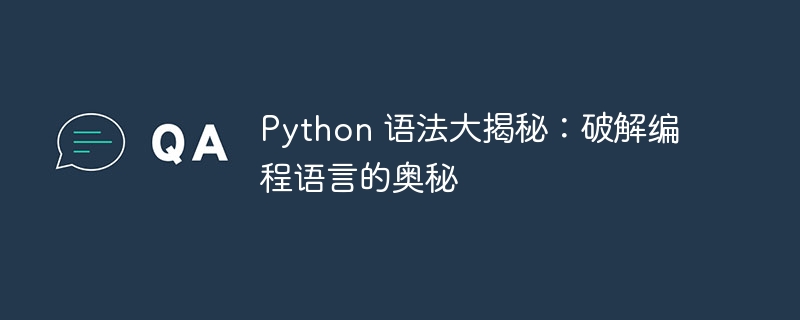Home >Backend Development >Python Tutorial >Python syntax revealed: cracking the secrets of programming languages
Python syntax revealed: cracking the secrets of programming languages
- 王林forward
- 2024-02-20 21:03:031279browse

python Syntax, data types, variables, flow control, functions, modules, classes and objects
introduction
Python As a popular high-level programming language, it is widely popular for its easy learning, concise syntax and powerful functions. A deep understanding of Python syntax is essential to mastering the language. This article will provide an in-depth analysis of various aspects of Python syntax to help you decipher the mysteries of this language and realize its powerful potential.
type of data
Python has a variety of data types used to represent different types of data, including:
- Integer (int): 1, 5, -7
- Floating point number (float): 1.5, 3.14
- String(str): "Hello", "world"
- Boolean value (bool): True, False
- List: [1, 2, "a"]
- Tuple: (1, "b", 3)
- Dictionary (dict): {"name": "John", "age": 30}
Variables and assignment
Variables are used to store values and can be assigned values using the assignment operator (=). For example:
name = "John" age = 30
Process Control
Python provides powerful flow control statements for controlling program flow:
- if-elif-else: Execute different code blocks based on conditions
- while: Repeat the code block until the condition is met
- for: Traverse a sequence or range
- break: Break out of the loop
- continue:Skip the current loop iteration
function
Functions are used to encapsulate blocks of code and perform specific tasks. They can accept parameters and return values. For example:
def greet(name):
print("Hello, " + name)
greet("John")# 输出:Hello, John
Module
Modules are reusable units of Python code that provide specific functionality. You can import modules using the import statement, for example:
import math print(math.pi)# 输出:3.141592653589793
Classes and Objects
Python supports object-oriented programming, where classes define object types and objects are instances of classes. For example:
class Person:
def __init__(self, name, age):
self.name = name
self.age = age
john = Person("John", 30)
print(john.name)# 输出:John
Operator
Python provides a variety of operators for performing arithmetic, logical and comparison operations:
- Arithmetic operators: ,-,*,/,%
- Logical operators: and, or, not
- Comparison operators: ==, !=, 95ec6993dc754240360e28e0de8de30a, d2e24fbfa3a7d998970671c0359d3643=
Special methods
Special methods (also called magic methods) in Python start and end with double underscores and are used to define specific behaviors of objects, for example:
-
__init__:Constructor of object -
__str__: String representation of the object -
__add__: Object addition operation
Advantages of Python syntax
Advantages of Python syntax include:
- Simplicity: The syntax is simple and easy to understand, making it easy for beginners to learn
- Readability: The code is highly readable, making collaboration and maintenance easy
- Flexibility: Dynamic typing and duck typing allow flexible handling of data at runtime
- Rich libraries: A large number of third-party libraries provide ready-to-use solutions for various tasks
in conclusion
Python syntax is the foundation of the language’s power. With a deep understanding of its data types, variables, flow control, functions, modules, classes, and objects, as well as operators and special methods, you can master the secrets of Python and build efficient, maintainable, and scalable applications.
The above is the detailed content of Python syntax revealed: cracking the secrets of programming languages. For more information, please follow other related articles on the PHP Chinese website!

